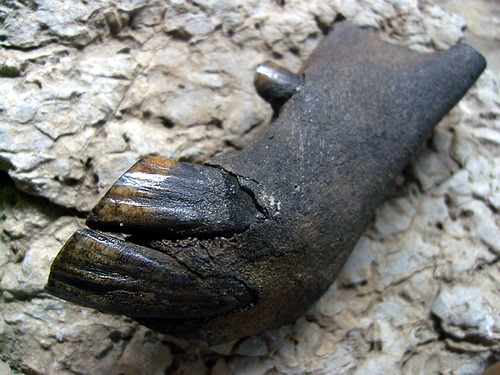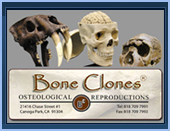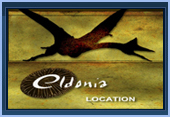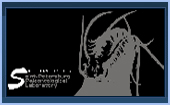Equus is a genus of animals in the family Equidae that includes horses, donkeys, and zebras. Within Equidae, Equus is the only extant genus. Like Equidae more broadly, Equus has numerous extinct species known only from fossils. This article deals primarily with the extant species.
The term equine refers to any member of this genus, including any horse.
Equines are medium to large mammals, with long heads, and necks with a mane. Their legs are slender and end in a single, unguligrade toe, protected by a horny hoof. They have long, slender, tails, either ending in a tuft, or entirely covered in flowing hair. They are adapted to generally open terrain, from plains and savannas, to mountains or deserts.
The range of equine monocular vision. Shaded areas represent blind spots.The pinnae ("ears") of equines are mobile, enabling them to easily localise the origin of sounds. They have two-color, or dichromatic vision. Their eyes are set back far on the head, giving them a wide angle of view, without entirely losing binocular vision. Equines also have a vomeronasal organ, that allows males to use the flehmen, or 'lip-curling' response to assess the sexual state of potential mates.
Equines are herbivores, and feed predominantly on tough, fibrous food, such as grasses and sedges. When in need, they will also eat other vegetable matter, such as leaves, fruits, or bark, but are normally grazers, not browsers. Unlike ruminants, with their complex stomachs, equines break down cellulose in the "hindgut" or cecum, a part of the colon. Their dentition is almost complete, with cutting incisors to crop food, and grinding molars set well back behind a diastema.
Equines are social animals, living in herds or bands. Horses, along with Plains and Mountain Zebras, have permanent herds generally consisting of a single male and a band of females, with the remaining males forming small "bachelor" herds. The remaining species have temporary herds, lasting only a few months, which may be either single-sexed or mixed. In either case, there are clear hierarchies established amongst the individuals, usually with a dominant female controlling access to food and water resources and the lead male controlling mating opportunities.
Females, usually called mares in horses and zebras, or, in the case of asses and donkeys, jennys, usually bear a single foal, after a gestation period of approximately 11 months. Young equines are able to walk within an hour of birth, and are weaned after four to thirteen months (animals living in the wild naturally wean foals at a later date than those under domestication). Depending on species, living conditions and other factors, females in the wild may give birth every year or every other year.
Equines who are not in foal generally have a seasonal estrous cycle, from early spring into autumn. Most females enter an anestrus period during the winter and thus do not cycle in this period. The reproductive cycle is controlled by the photoperiod (length of the day), with estrus triggered when the days begin to lengthen. Anestrus prevents the female from conceiving in the winter months, as that would result in her foaling during the harshest part of the year, a time when it would be more difficult for the foal to survive. However, equines who live near the equator, where there is less change in length of day from season to season, have no anestrus period, at least in theory. Further, for reasons that are not clear, about twenty percent of domestic mares in the Northern Hemisphere will cycle the year round.
말목[奇蹄目] 말과 얼룩말아속 포유류의 총칭.
학명-Equus
분류-말목 말과 얼룩말아속
생활방식-작은 무리 또는 큰 무리 이룸, 늙은 수컷이 우두머리가 됨
크기-몸길이 1.1∼1.5m
생식-임신기간 300∼375일, 한배에 1마리 낳음
수명-약 25년
서식장소-사바나
분포지역-사하라사막 이남의 아프리카
몸에 아름다운 가로줄무늬가 있으며, 모두 4종이 있다. 몸길이는 종류에 따라서 다르나, 1.1∼1.5m이며, 몸에 비해서 머리가 크고, 꼬리 끝에만 긴 털송이가 있다. 발굽은 당나귀보다 넓고 말보다는 좁다. 귀는 당나귀와 말의 중간 정도이다.
사바나에 서식하며 작은 무리를 이루거나 수천 마리의 큰 무리를 이룬다. '누'와 같은 영양이나 기린과 더불어 살며, 해질 무렵이나 이른 아침에 물가에서 풀을 먹는다. 무리는 늙은 수컷이 우두머리가 되어 이끌게 되므로 우두머리는 항상 무리의 선두에서 앞장을 선다.
시각과 후각이 예민하다. 적에 대해서는 둥글게 감싸고 뒷다리로 걷어차며, 집단으로 방어한다. 천적은 사자와 표범, 하이에나 등이다. 임신기간은 300∼375일이며, 한배에 1마리의 새끼를 낳는다. 어린 새끼는 생후 즉시 달릴 수가 있다. 수명은 약 25년이다. 이전에는 가축으로 사육시험을 시도하여 보았으나 말이나 당나귀보다 내구력이 결핍되어 있어 실패하였다. 사하라사막 이남의 아프리카에 분포한다.
가장 큰 그레비얼룩말(Equus grevyi)은 어깨높이 1.4∼1.6m이며, 줄무늬가 좁고, 그 수가 많다. 배에는 줄무늬가 없으며, 귀가 둥글고 크다. 발굽은 너비가 넓다. 사바나얼룩말(E. burchelli)은 몸의 후반부에 줄무늬가 없고, 어깨높이가 1.3∼1.4m이다. 소형으로 어깨높이가 1∼1.3m인 동아프리카의 그랜트얼룩말(E. burchelli bohmi)과 몸통의 줄무늬와 줄무늬 사이에 희미한 줄무늬가 있는 채프먼얼룩말(E. b. chapmani) 등 2아종으로 나뉜다.
그 밖에 1800년대 말에 절멸한 콰가얼룩말(E. quagga)은 어깨높이가 약 1.4m이고, 목 밑에 살이 늘어져 있지 않으며, 귀는 짧다. 남서아프리카의 산지에 소수가 분포하는 산얼룩말(E. zebra)은 어깨높이 1.2∼1.35m로 목 밑에 작은 혹이 있다. 바위가 많은 곳을 잘 걸어다닌다.












































 수량을 선택해주세요.
수량을 선택해주세요.





































